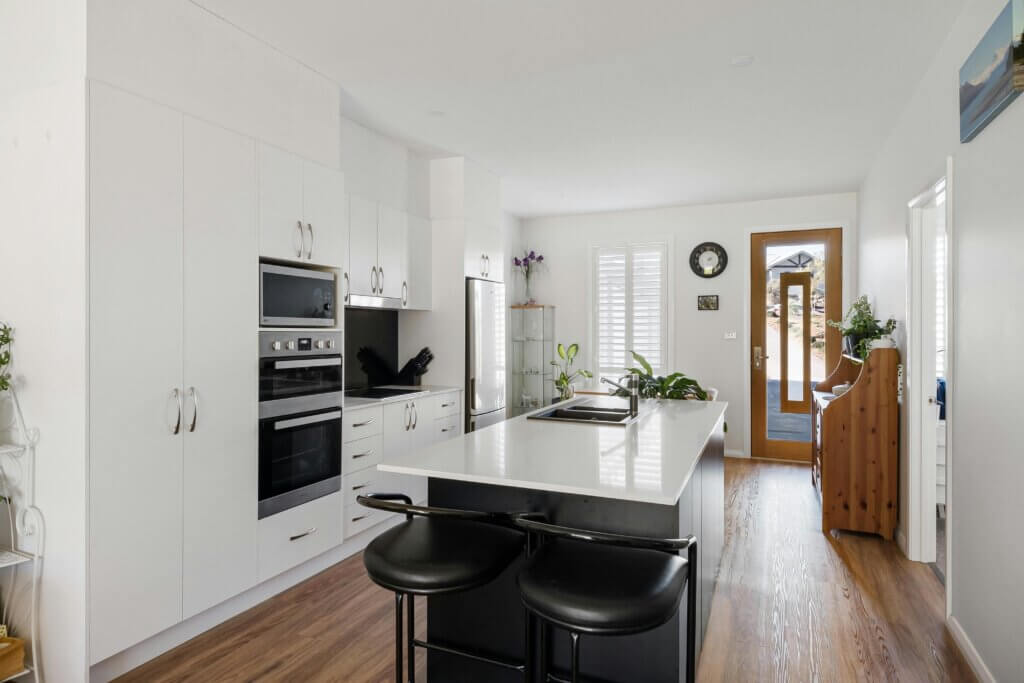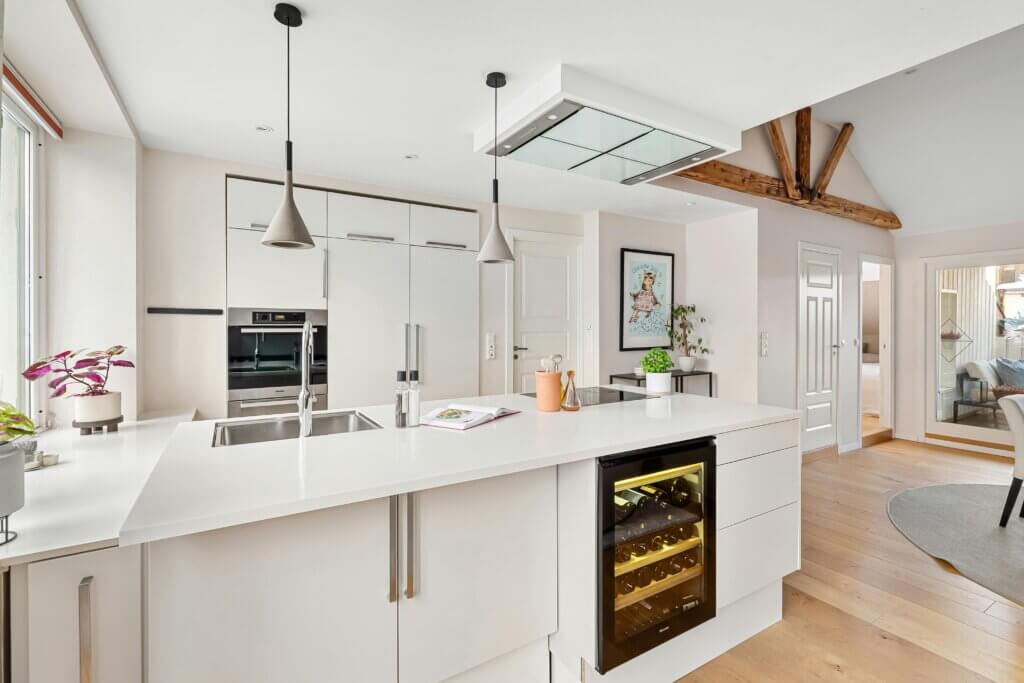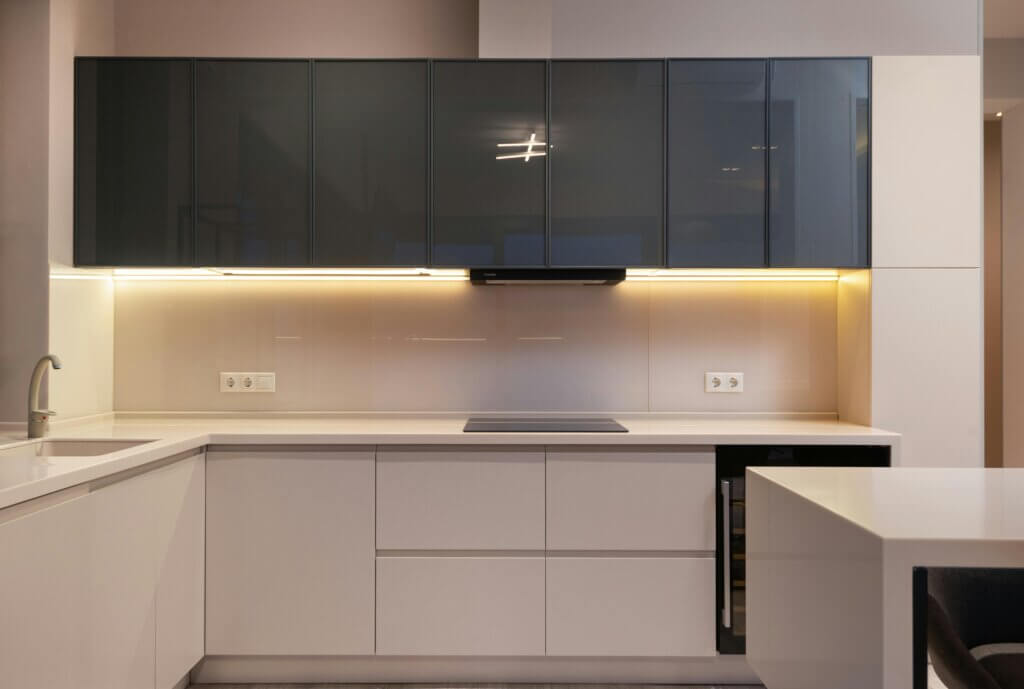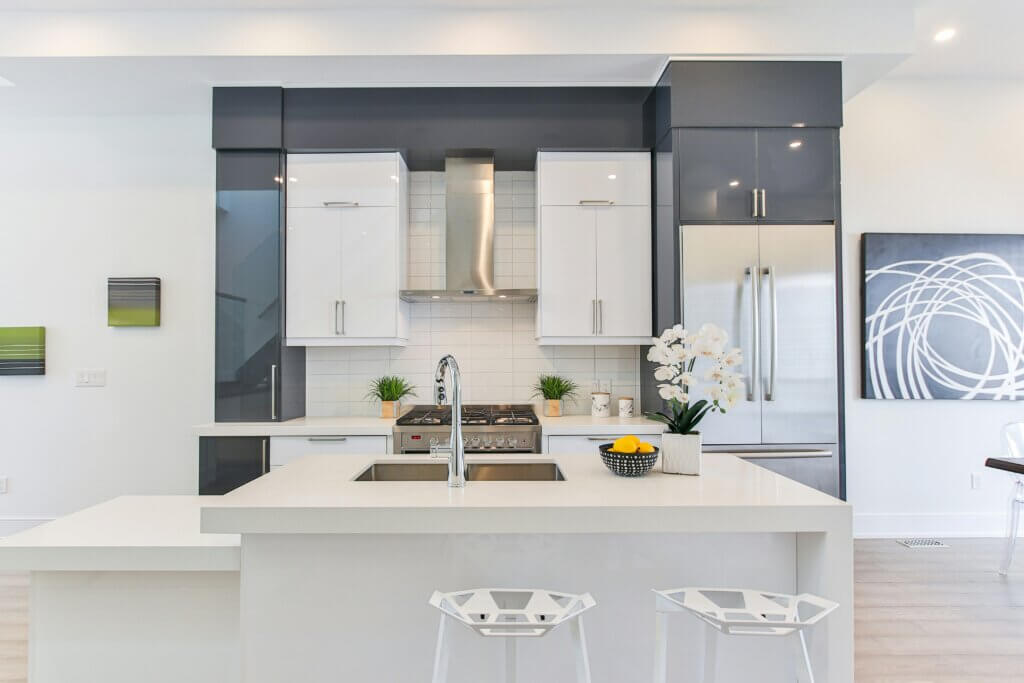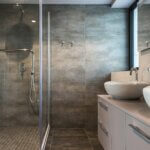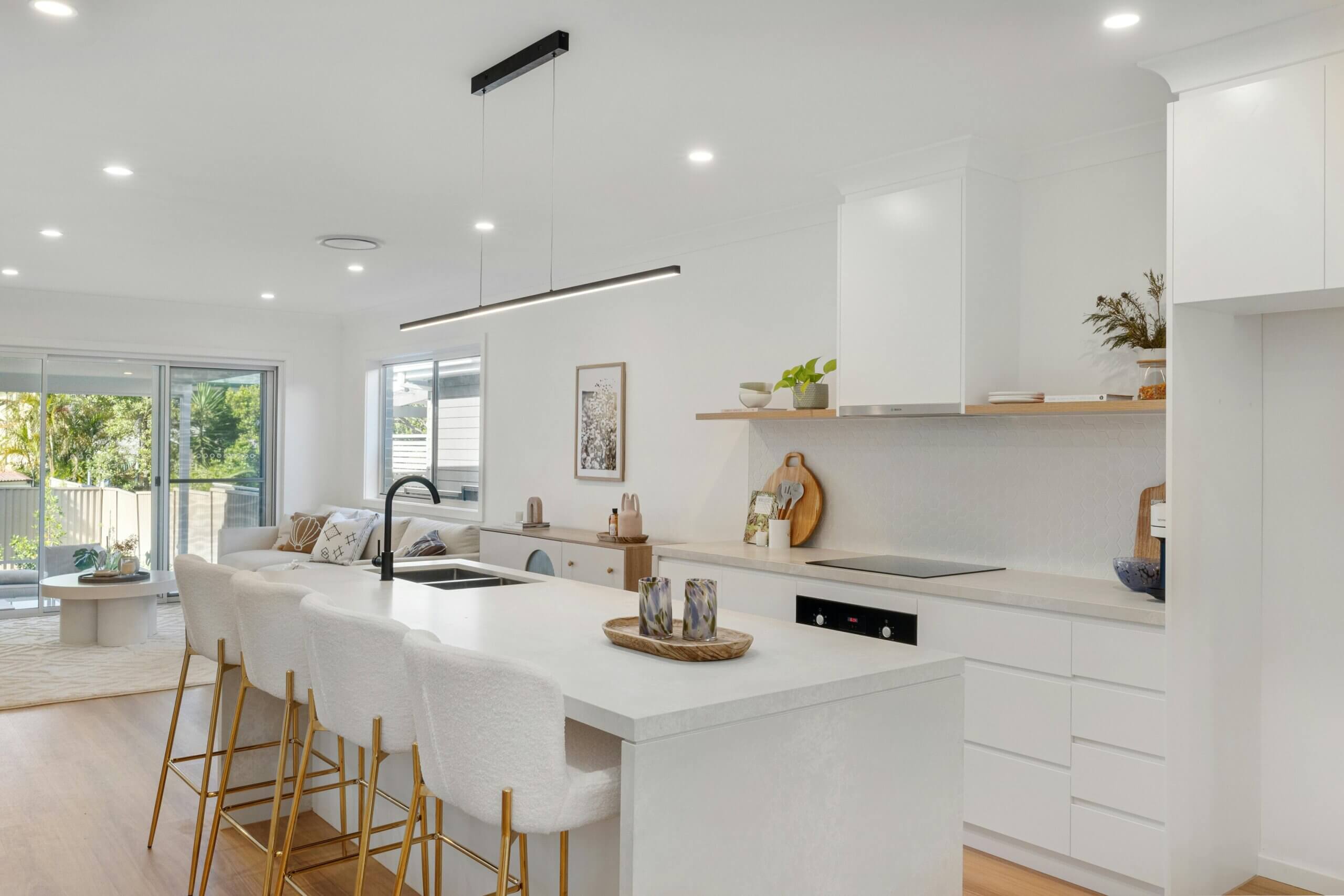
Embracing Simplicity: The Rise of Minimalist Kitchen Design16 min read
Have you ever walked into a kitchen and felt overwhelmed by the sheer amount of stuff—appliances cluttering the countertops, cabinets overflowing with gadgets you hardly ever use? It’s a common experience in today’s world, where we’re bombarded with endless choices and constantly inundated with stuff vying for our attention.
But minimalist kitchen design offers a different approach—one that invites you to pare back, to simplify, to focus on what truly matters. It’s not just about aesthetics (although the clean lines and sleek surfaces are undeniably beautiful); it’s about creating a space that supports your lifestyle, nurtures your well-being, and allows you to breathe a little easier.
And here’s the thing: minimalist kitchen design is not about deprivation or austerity; it’s about intentionality. It’s about choosing quality over quantity, about investing in pieces that are both beautiful and functional, and about creating a space that reflects your values and supports your goals.
Contents
Characteristics of a Minimalist Kitchen Design
Minimalist kitchen design is characterized by several key features that collectively create a space that is clean, uncluttered, and visually soothing. Here are some of the defining characteristics of minimalist space.
Sleek Surfaces
Minimalist kitchens often feature smooth, clean surfaces with minimal adornment. This includes sleek countertops made from materials like quartz, granite, or stainless steel, and white oak cabinets as well as glossy cabinetry with simple, handle-less designs.
Neutral Color Palette
A muted color scheme is typical of minimalist kitchens, with shades of white, gray, beige, and black dominating the space. These neutral tones help create a sense of openness and tranquility, allowing other elements in the room to stand out.
Clean Lines
Clean, straight lines are a hallmark of minimalist interior design. From the cabinetry to the fixtures to the furniture, every element in a minimalist kitchen is characterized by its simplicity and geometric precision.
Limited Decor
In a minimalist kitchen, less is more when it comes to decor. Instead of cluttering the space with knick-knacks and accessories, minimalist kitchens often feature just a few carefully chosen items, such as a statement pendant light or a piece of artwork, to add visual interest without overwhelming the senses.
Hidden Storage
To maintain the clean, uncluttered look of a minimalist kitchen, storage is often cleverly integrated into the design. This may include hidden cabinets, pull-out drawers, or built-in shelving that keeps kitchen essentials neatly tucked away out of sight.
Functional Layout
Functionality is paramount in minimalist kitchen design. The layout is carefully planned to maximize efficiency and usability, with an emphasis on creating a seamless flow between the different work zones, such as cooking, prepping, and cleaning.
Natural Elements
While minimalist kitchens are known for their simplicity, they often incorporate natural elements to add warmth and texture to the space. This may include wood accents, such as butcher block countertops or open shelving, as well as indoor plants or fresh flowers to bring a touch of nature indoors.
Why Minimalist Kitchen Design Become Popular
You know, it’s fascinating how minimalist kitchen design has taken off in recent years. It seems like everywhere you look, people are embracing this clean, streamlined aesthetic. And honestly, here are a few key reasons why it’s become so popular in kitchen remodels.
First off, it’s all about simplicity. In today’s fast-paced world, where we’re constantly bombarded with information and stimuli, something is appealing about coming home to a kitchen that feels calm and uncluttered. The minimalist design helps create that sense of tranquility by stripping away the excess and focusing on the essentials.
Plus, there’s a practical side to it too. I mean, who hasn’t struggled with a cluttered kitchen at some point? With minimalist design, everything has its place, and there’s no room for unnecessary clutter. It makes cooking and meal prep so much easier when you’re not constantly digging through overstuffed cabinets or trying to find counter space amidst a sea of gadgets.
And let’s not forget about aesthetics. There’s a timeless elegance to minimalist kitchens that just can’t be beat. The clean lines, the neutral color palettes, the sleek surfaces—it all adds up to a space that feels modern and sophisticated, yet still warm and inviting.
There’s also a deeper philosophy behind minimalist design that resonates with a lot of people. It’s about living with intention, about surrounding yourself with things that truly bring you joy, and letting go of the rest. In a world that’s always pushing us to want more, the minimalist style of design encourages us to be content with less—to focus on quality over quantity and to appreciate the beauty of simplicity.
Minimalist Kitchen Design Ideas
Minimalist kitchen design isn’t just about empty spaces and white walls—it’s about creating a harmonious balance between form and function, simplicity and sophistication. Here are some captivating ideas to help you bring the essence of minimalism into your kitchen.
Layout and Space Optimization
In a minimalist kitchen, the layout is often open and uncluttered. Consider removing unnecessary walls to create an open-plan layout that seamlessly integrates the kitchen with adjacent living or dining areas.
Maximize space by incorporating clever storage solutions such as pull-out refrigerator and pantry shelves, hidden cabinets, or under-counter storage drawers. Utilize vertical space with tall cabinets or wall-mounted shelving to keep countertops free from clutter.
Cabinetry and Storage
In a minimalist kitchen, cabinetry and storage solutions play a pivotal role in maintaining a sleek and clutter-free aesthetic. Opting for modern cabinetry with clean lines and minimal ornamentation, such as flat-panel doors in neutral tones, sets the foundation for a minimalist look.
Handle-less cabinets or integrated handles further contribute to the seamless and uninterrupted appearance of the kitchen space. Efficient storage solutions are essential, with pull-out pantry shelves, corner cabinets with rotating shelves, and drawers with built-in dividers maximizing every inch of available space.
Hidden storage options, like appliance garages and retractable doors, help conceal clutter and maintain a clean look, while vertical storage solutions, such as tall cabinets and wall-mounted shelving units, offer additional space without sacrificing aesthetics.
Open shelving or glass-front cabinets provide opportunities for displaying decorative items or frequently used kitchenware while still adhering to minimalist principles.
Countertops and Materials
Neutral tones such as white, gray, or beige are often chosen for countertops to create a timeless and cohesive look. Materials like quartz, granite, or solid surfaces are popular choices due to their durability, ease of maintenance, and sleek appearance. These materials not only provide a clean and minimalist backdrop but also withstand the rigors of daily use in the modern kitchen.
Furthermore, minimalist kitchens prioritize simplicity and functionality, making it essential to select countertops that are both practical and visually appealing. Considerations such as stain resistance, scratch resistance, and heat resistance are crucial factors when choosing kitchen countertop materials.
Quartz countertops, in particular, are highly favored for their non-porous surface, making them resistant to stains and bacteria growth. Additionally, minimalist kitchens often feature seamless countertop installations with minimal seams or joints, further enhancing the clean and streamlined aesthetic of the space.
Lighting
Natural kitchen lighting is often maximized by strategically placing windows, skylights, or glass doors, creating a bright and inviting atmosphere while reducing the need for artificial lighting during the day. Large windows or floor-to-ceiling glass doors flood the space with natural light and blur the boundaries between indoor and outdoor spaces, enhancing the sense of openness and connectivity.
To supplement natural light, artificial lighting is carefully chosen to illuminate the kitchen efficiently and enhance its minimalist aesthetic. Recessed lighting, also known as downlights or pot lights, is commonly used to provide ambient lighting throughout the space while maintaining a clean and uncluttered ceiling.
Pendant lights are another popular choice, offering task lighting over kitchen islands or dining areas while adding a touch of style and visual interest. Pendant lights with sleek and minimalist designs complement the overall aesthetic of the kitchen without overpowering the space.
In addition to ambient and task lighting, under-cabinet lighting is often installed to provide focused illumination on countertops, enhancing visibility for food preparation tasks while creating a warm and inviting ambiance. LED strip lights or puck lights are discreet options that seamlessly integrate into the cabinetry, offering functional lighting without detracting from the minimalist design.
Flooring
The choice of kitchen flooring should align with the minimalist principles of simplicity, functionality, and understated elegance. Popular flooring options for minimalist kitchens include porcelain tiles, hardwood, and polished concrete, each offering distinct benefits while maintaining a clean and cohesive look.
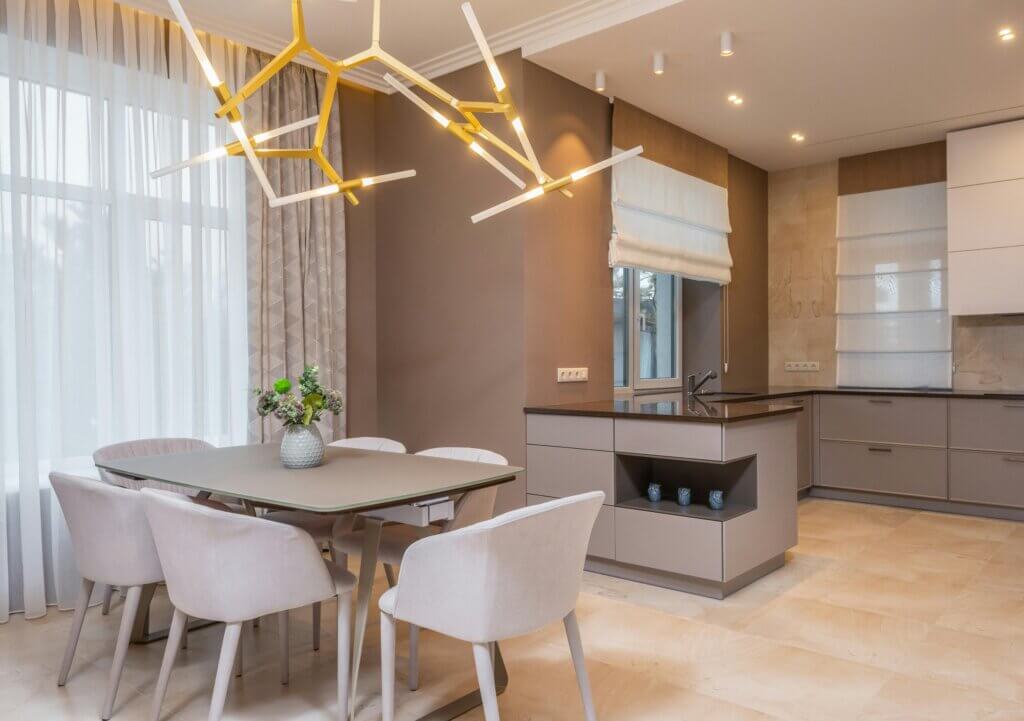
Porcelain tiles
These are an excellent choice for minimalist kitchens due to their durability, ease of maintenance, and wide range of neutral color options. They can mimic the appearance of natural stone or wood, providing a sleek and modern look while being resistant to moisture, stains, and scratches.
Light-colored porcelain tiles, such as shades of white, gray, or beige, help to create a bright and airy atmosphere, enhancing the sense of space and cleanliness.
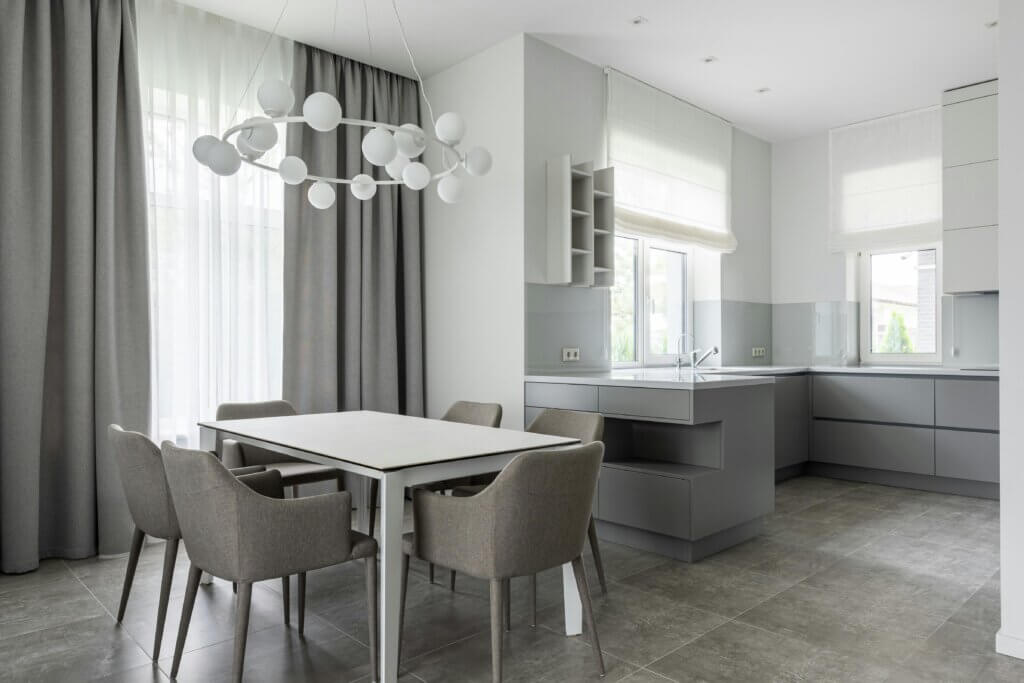
Polished concrete flooring
This offers a contemporary and industrial-chic look that aligns well with minimalist principles. It is highly durable, low-maintenance, and can be customized with various finishes and stains to achieve the desired hue and sheen.
Polished concrete floors reflect light, contributing to a brighter and more expansive feel in the kitchen. Additionally, their seamless appearance and ability to withstand heavy foot traffic make them a practical choice for busy kitchens.
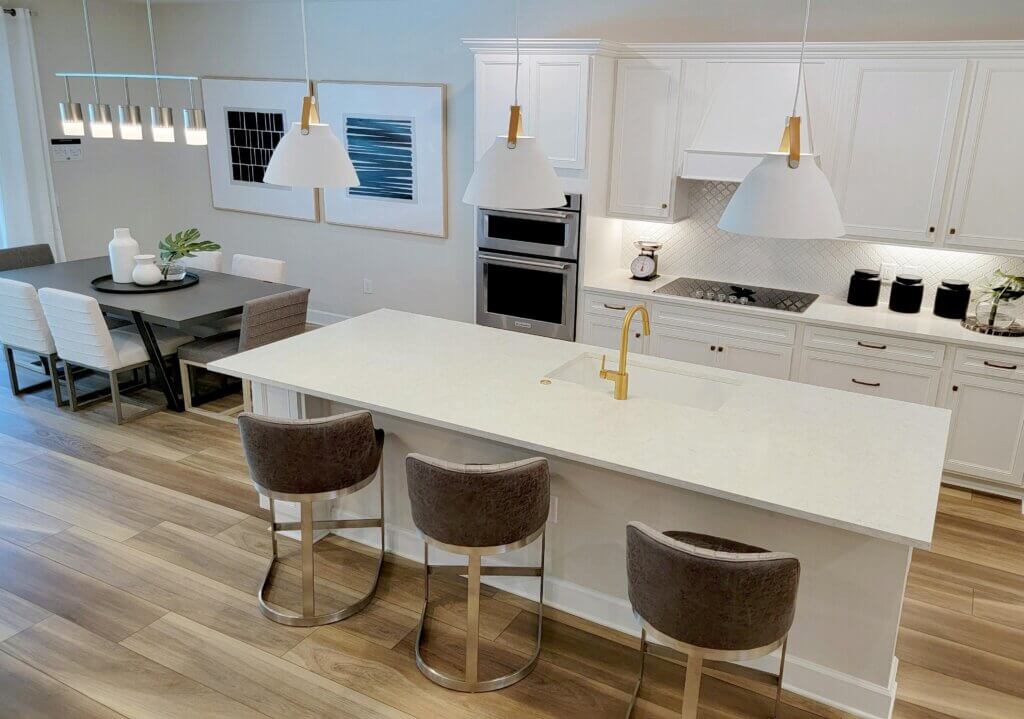
Hardwood flooring
This is another favored option for minimalist kitchens, bringing warmth and natural beauty to the space. Opt for light or medium-toned woods like oak, maple, or ash, which can complement the neutral palette typical of minimalist design.
Hardwood floors are timeless and versatile, adding a touch of sophistication while being durable and easy to maintain with proper care. The natural grain patterns and textures of wood provide subtle visual interest without overwhelming the minimalist aesthetic.
Appliances
In a minimalist kitchen, appliances are chosen with a focus on functionality, efficiency, and streamlined design. The goal is to integrate appliances seamlessly into the overall aesthetic white minimalist kitchen, ensuring they contribute to the clean and uncluttered look of the space.
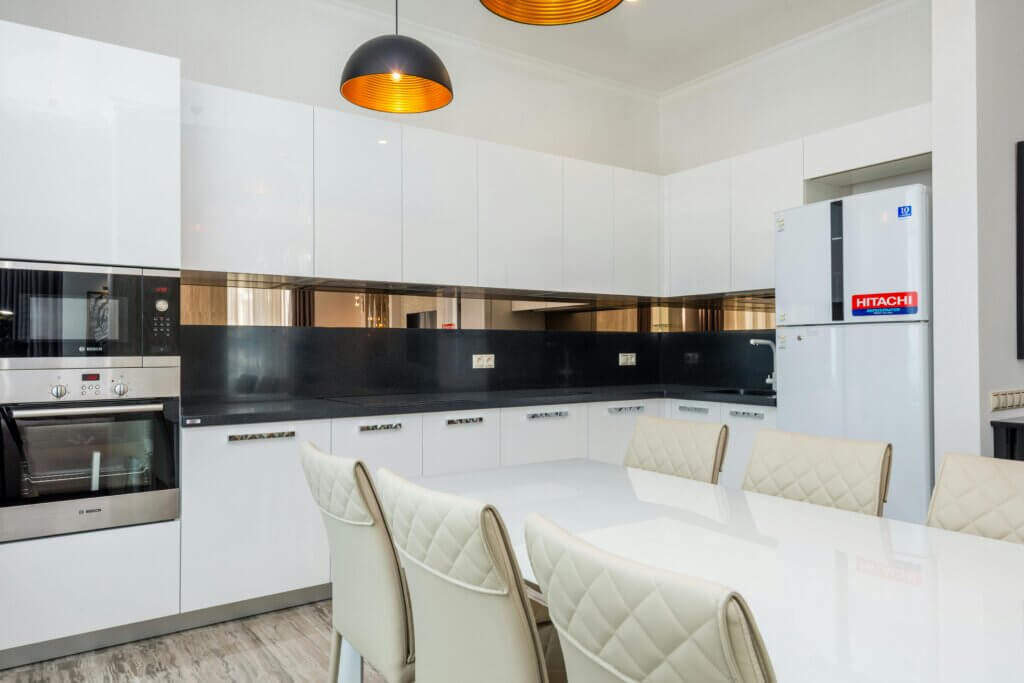
Built-in Appliances
- Built-in or integrated appliances are ideal for a minimalist kitchen. These appliances fit flush with the cabinetry, creating a cohesive and uninterrupted visual flow.
- Options like built-in ovens, microwaves, and dishwashers can be concealed behind cabinet doors, maintaining the sleek appearance of the kitchen.
- Induction cooktops with smooth, flat surfaces blend seamlessly with countertops and are easy to clean, contributing to the minimalist ethos of simplicity and practicality.
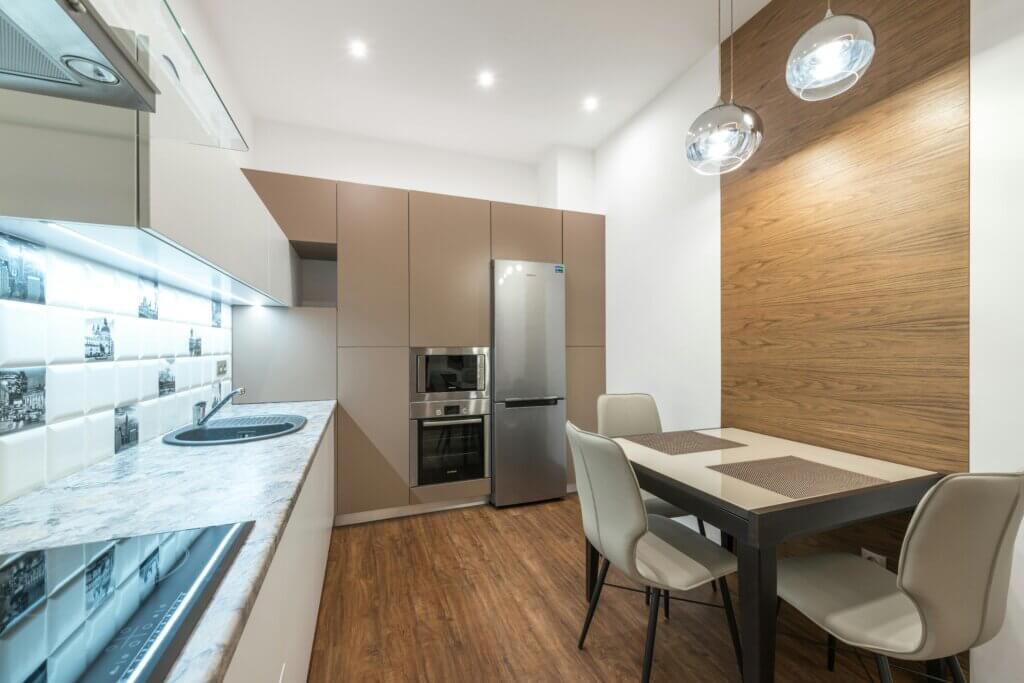
Sleek and Modern Designs
- Select appliances with minimalist designs, characterized by clean lines, smooth surfaces, and intuitive controls.
- Stainless steel is a popular choice for its modern look and durability. Black or white appliances can also work well, depending on the overall color scheme of your kitchen.
- Avoid appliances with excessive detailing or bulky handles. Instead, opt for models with integrated or touch-sensitive controls that maintain a streamlined look.
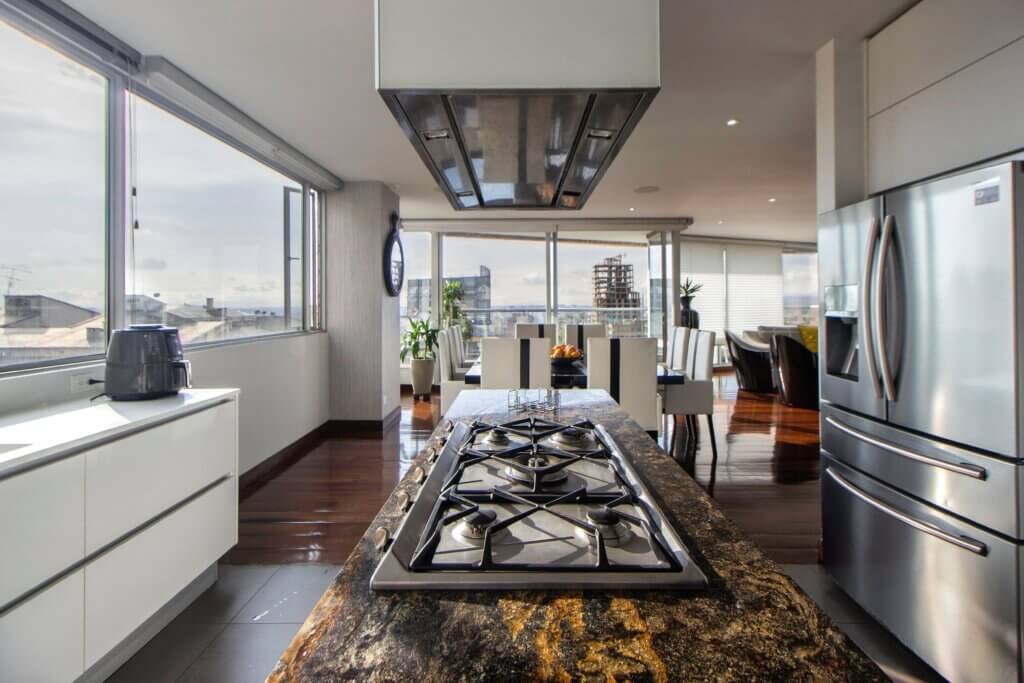
Multi-functional Appliances
- To save space and reduce clutter, consider multi-functional appliances. For example, a combination oven and microwave can serve dual purposes, freeing up valuable counter space.
- Appliances with advanced features, such as refrigerators with built-in water dispensers and ice makers, can enhance convenience while maintaining a minimalist appearance.

Small Appliances and Storage
- Minimize the number of small appliances on your countertops. Store items like toasters, blenders, and coffee makers in cabinets or appliance garages when not in use to keep surfaces clear.
- Choose compact, multi-purpose small appliances that can perform multiple functions, such as a food processor that can also blend or knead dough.
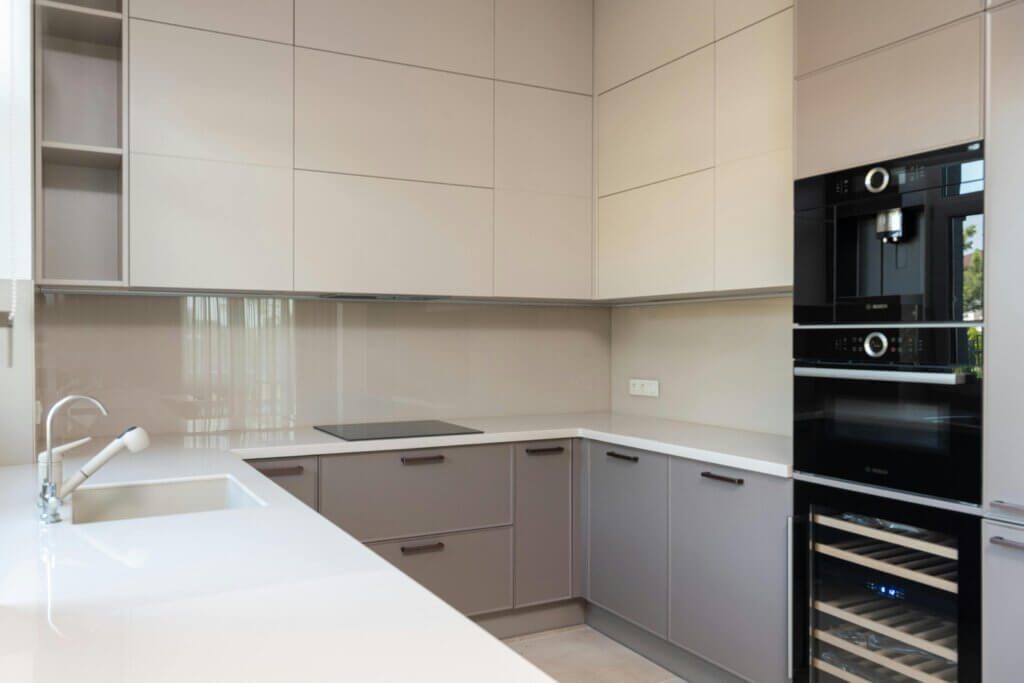
Smart Appliances
- Incorporate smart appliances that offer advanced functionality and can be controlled via smartphone apps or voice commands. These appliances can help streamline your kitchen tasks and maintain a clutter-free environment.
- Smart refrigerators, ovens, and dishwashers often come with sleek, minimalist designs and can provide features like remote monitoring, automated cooking settings, and energy efficiency.
Finishing Touches
Finishing touches in a minimalist kitchen are all about adding subtle details that enhance the overall aesthetic without overwhelming the space. These elements should be carefully chosen to complement the clean lines, neutral color palette, and functional design of the kitchen.
Natural Elements and Materials
- Incorporate natural materials like wood, stone, or plants to add warmth and texture to the space. For example, a wooden cutting board, a stone fruit bowl, or a few potted herbs can introduce organic elements that soften the minimalist look.
- Choose materials that have subtle patterns and textures. For instance, a marble countertop with gentle veining or a wooden utensil holder with a smooth grain can provide visual interest without detracting from the minimalist design.
Decorative and Functional Accessories
- Select accessories that are both decorative and functional. Items like a sleek knife block, minimalist salt and pepper mills, or stylish storage jars can add personality to your kitchen while serving practical purposes.
- Keep the number of decorative items to a minimum and ensure they align with the overall aesthetic. For example, a single piece of modern art or a simple vase with fresh flowers can be enough to add a touch of elegance.
Hardware and Fixtures
- Opt for minimalist hardware and fixtures with clean lines and simple designs. Matte black, brushed nickel, or stainless steel finishes can enhance the modern look of your kitchen.
- Choose faucets, cabinet handles, and light fixtures that are understated yet stylish. A single-handle faucet with a sleek profile or linear cabinet pulls can contribute to the cohesive minimalist aesthetic.
Lighting Accents
- Use lighting to highlight key areas and create ambiance. Under-cabinet lighting, for instance, can illuminate countertops and provide a warm glow that enhances the kitchen’s inviting feel.
- Consider pendant lights over the kitchen island or dining area. Choose designs that are simple and elegant, such as a single, oversized pendant or a series of small, uniform pendants.
Personal Touches and Art
- Add personal touches that reflect your style while maintaining the minimalist theme. This could include a favorite cookbook displayed on a stand, a piece of minimalist artwork, or a framed family photo in a simple frame.
- Ensure that personal items are curated and not overly sentimental. The goal is to add character without clutter.
‘
Color Accents
- Introduce subtle color accents through accessories and small decor items. Soft, muted tones can add depth and interest without overwhelming the neutral base of the minimalist kitchen.
- Consider textiles like kitchen towels, rugs, or seat cushions in complementary colors or patterns. Keep these accents minimal and cohesive to maintain the overall aesthetic.
In Essence
In this age of constant connectivity and sensory overload, the minimalist kitchen offers a respite—a sanctuary where simplicity reigns supreme. It’s a place to savor the joys of cooking, to gather with loved ones, and to nourish both body and soul.
By embracing simplicity, clean lines, and functional design principles, you can create a minimalist kitchen that not only looks stunning but also enhances your daily cooking and dining experience. So, as we embrace the art of living well, let us also embrace the beauty of less—a timeless elegance that transcends trends and speaks to the essence of what it means to feel truly at home.
In the minimalist kitchen, less is not just more; it’s everything.
Are you ready to embrace the beauty of simplicity in your kitchen?
Don’t wait—transform your kitchen into a space of calm and sophistication. Contact us now to schedule a consultation and our team is here to help you create the perfect minimalist kitchen tailored to your needs and style.





